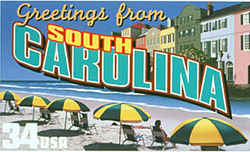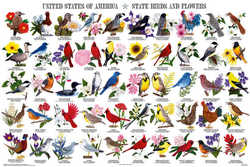
South Carolina Symbols
South Carolina State Wild Game Bird
Wild Turkey

(Meleagris Gallopavo)
Adopted in 1976.
The wild turkey, (Meleagris Gallopavo,) - designated by Act No. 508, 1976) is South Carolina's official State Wild Game Bird. The wild turkey is a bird of the deep woods and hardwood forests. It is a prized game bird and is considered a table delicacy. Wild turkeys are hunted only during the spring season and are found throughout the State, primarily on game management lands.
Did you know that: The Wild Turkey has been proclaimed the official state game bird in each of the following states
Alabama | Massachusetts | Oklahoma | South Carolina
South Carolina State Wild Game Bird: Wild Turkey

The wild turkey is one of the largest birds in North America. An adult male can grow up to 4 feet long from his beak to his tail. Males have a dark, iridescent body. The flight feathers are black with brown stripes and are barred with white. M. gallopavo has red wattles, a caruncle, and a blackish breast tuft. The wattle comprises the fleshy lobes hanging down from the chin or throat. The caruncle is the wart-like projections of the skin attached to the upper part of the forehead. The legs are spurred and spurs can grow as long as 3.175 centimeters. The leg scales are pink, pinkish gray, or silver gray. The head of the adult gobbler (male) is red, blue, or white depending on the bird's emotional status and on the season. Female turkeys are smaller and duller than males, and lack a breast tuft. Females also have a grayish head and the back of the neck is feathered.
Characteristics of the Wild Turkey
Food Habits
Preferred habitats include mature forests, open woodlands, and farm areas. During the non-breeding season, the birds forage in flocks on the ground for acorns, seeds, some leaves, salamanders, worms, snails, and insects. Food items are swallowed whole and ground up in the bird's gizzard.
Reproduction
Males perform courtship displays by strutting and gobbling.During the spring, males will fan out their tails, strut and gobble in an attempt to attract and hold a harem of females. The call of the male Wild Turkey (also called a gobble) can be heard a 1.61 kilometers away. The Wild Turkey is polygamous, therefore one male will attempt to mate with several females. Eggs are laid two to three weeks after copulation. The hen usually nests on the ground in a depression, and the nest is usually surrounded by dense brush, vines, tangles, deep grass, or fallen tree tops. The nest contains 8-15 eggs. The incubation period is 28 days.
Behavior
By day turkey can be seen grazing in fields and woodlands. At night the turkey roosts in trees. The Wild Turkey is a very wary bird with keen eyesight and hearing. In spite of its large size and rather awkward appearance, the wild turkey is a powerful flier, reaching speeds of up to 55 mph over short distances. Turkeys will most often fly hard and fast up through the treetops, then set their wings and glide back to the ground. In the fall, the turkey flock with several males accompanying several females. There is no calling (unless the flock gets broken up) and there are no displays similar to those seen in the spring. The main objective is to gather enough fat reserves for the winter.
Habitat
Habitats preferred by wild turkeys include mixed coniferous and deciduous forests. Agricultural fields, orchards, and seasonal marshes are also locations favored by the turkey. Wild turkeys are hunted only during the spring season and are found throughout the State, primarily on game management lands.
South Carolina Code of Laws
The law designating the South Carolina wild turkey as the official South Carolina state wild game bird is Section SECTION 1-1-635 (Official State wild game bird.) of the South Carolina Code of Laws, Title 1 (Administration of the Government) Chapter 1 (GENERAL PROVISIONS) Article 9 (STATE EMBLEMS, PLEDGE TO STATE FLAG, OFFICIAL OBSERVANCES) Section 1-1-635
Title 1 - Administration of the Government.
CHAPTER 1. GENERAL PROVISIONS.
ARTICLE 9. STATE EMBLEMS, PLEDGE TO STATE FLAG, OFFICIAL OBSERVANCES.
SECTION 1-1-635.
SECTION 1-1-635. Official State wild game bird.
The South Carolina Wild Turkey (Meleagris Gallopavo) is the official wild game bird of the State.
Taxonomic Hierarchy: Wild Turkey
Kingdom: Animalia (animal)
Phylum: Chordata (chordates)
Class: Aves - Aves (birds)
Order: Galliformes (fowls)
Family: Phasianidae - Partridges, Turkeys, Grouse, Pheasants, Quail, cailles, faisans
Subfamily: Meleagridinae - Turkeys
Genus: Meleagris Linnaeus, 1758 - Turkeys
Species: Meleagris gallopavo Linnaeus, 1758 - Guajolote norteno, Wild Turkey, dindon sauvage
Taxonomic Serial No.: 176135







